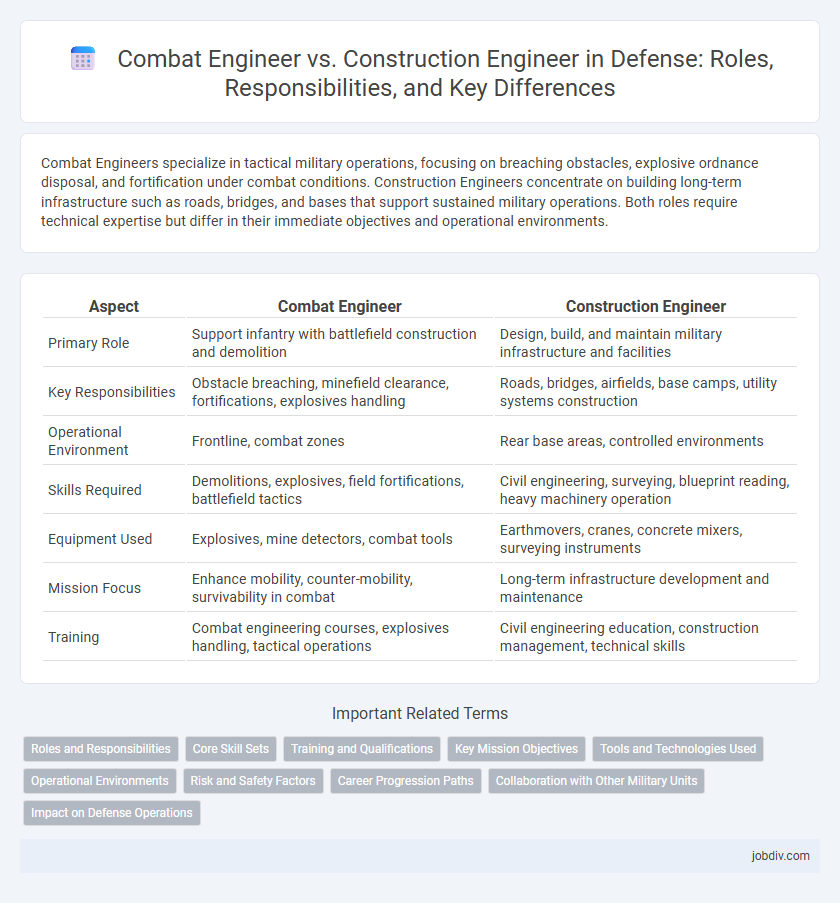Combat Engineers specialize in tactical military operations, focusing on breaching obstacles, explosive ordnance disposal, and fortification under combat conditions. Construction Engineers concentrate on building long-term infrastructure such as roads, bridges, and bases that support sustained military operations. Both roles require technical expertise but differ in their immediate objectives and operational environments.
Table of Comparison
| Aspect | Combat Engineer | Construction Engineer |
|---|---|---|
| Primary Role | Support infantry with battlefield construction and demolition | Design, build, and maintain military infrastructure and facilities |
| Key Responsibilities | Obstacle breaching, minefield clearance, fortifications, explosives handling | Roads, bridges, airfields, base camps, utility systems construction |
| Operational Environment | Frontline, combat zones | Rear base areas, controlled environments |
| Skills Required | Demolitions, explosives, field fortifications, battlefield tactics | Civil engineering, surveying, blueprint reading, heavy machinery operation |
| Equipment Used | Explosives, mine detectors, combat tools | Earthmovers, cranes, concrete mixers, surveying instruments |
| Mission Focus | Enhance mobility, counter-mobility, survivability in combat | Long-term infrastructure development and maintenance |
| Training | Combat engineering courses, explosives handling, tactical operations | Civil engineering education, construction management, technical skills |
Roles and Responsibilities
Combat engineers specialize in battlefield mobility, countermobility, and survivability by constructing fortifications, clearing obstacles, and handling explosives to support combat operations. Construction engineers focus on building and maintaining infrastructure such as roads, bridges, airfields, and facilities to ensure operational readiness and sustainment. Both roles require technical expertise, but combat engineers operate under direct combat conditions while construction engineers primarily support long-term military infrastructure projects.
Core Skill Sets
Combat Engineers specialize in battlefield construction, demolition, and obstacle breaching, emphasizing rapid infrastructure creation under hostile conditions and expertise in explosives and fortifications. Construction Engineers focus on large-scale, permanent infrastructure projects such as building airfields, bridges, and bases, with core skills in civil engineering, project management, and heavy equipment operation. Both roles require strong problem-solving abilities, but Combat Engineers prioritize tactical adaptability and combat readiness, while Construction Engineers emphasize structural integrity and long-term sustainability.
Training and Qualifications
Combat engineers undergo rigorous military training focused on explosives handling, obstacle breaching, and tactical field operations, emphasizing physical fitness and combat readiness. Construction engineers receive specialized education in civil engineering principles, project management, and infrastructure design, often requiring a professional engineering license. Both roles demand strong problem-solving skills, but combat engineers prioritize battlefield effectiveness while construction engineers concentrate on structural integrity and long-term infrastructure development.
Key Mission Objectives
Combat Engineers specialize in breaching obstacles, fortifying defenses, and conducting demolition to support front-line troops, ensuring mobility and survivability in hostile environments. Construction Engineers focus on building and maintaining infrastructure such as airfields, roads, and base facilities, providing essential logistics support to sustain military operations. Both roles are critical for mission success, with Combat Engineers enabling rapid maneuver warfare and Construction Engineers ensuring long-term operational readiness.
Tools and Technologies Used
Combat engineers utilize specialized breaching tools, explosives, and mine-clearing equipment designed for rapid obstacle removal and field fortification under combat conditions. Construction engineers leverage advanced heavy machinery, such as bulldozers, cranes, and earthmovers, alongside blueprint software and structural analysis technology for building permanent infrastructure and facilities. Both roles integrate GPS navigation and communication systems to enhance operational accuracy and coordination in defense environments.
Operational Environments
Combat Engineers operate primarily in tactical, high-threat operational environments, providing critical support in mobility, counter-mobility, and survivability tasks such as breaching obstacles, fortifications, and explosive ordnance disposal. Construction Engineers focus on building and maintaining infrastructure like bases, airfields, and roads in more secure or rear operational zones, ensuring long-term support and sustainability for military operations. The distinct operational environments dictate Combat Engineers' emphasis on rapid, adaptive engineering under fire, while Construction Engineers prioritize durable, large-scale construction projects in stabilized areas.
Risk and Safety Factors
Combat engineers operate in high-risk environments involving explosives, fortifications, and rapid obstacle clearance, necessitating rigorous safety protocols to mitigate threats such as landmines and enemy fire. Construction engineers focus on designing and building infrastructure in comparatively controlled settings, emphasizing structural safety, compliance with engineering standards, and long-term durability. Risk management in combat engineering prioritizes immediate hazard response and soldier protection, whereas construction engineering concentrates on minimizing accidents and ensuring safe operational conditions during project execution.
Career Progression Paths
Combat Engineers develop expertise in military tactics, explosives, and field fortifications, progressing into roles such as demolition experts, route clearance specialists, or combat engineering officers. Construction Engineers focus on designing, planning, and overseeing infrastructure projects, advancing towards positions like project managers, civil engineering supervisors, or infrastructure planners within the military. Both career paths offer opportunities for leadership development, specialized training, and integration into joint operations, enhancing strategic impact and technical proficiency in defense environments.
Collaboration with Other Military Units
Combat Engineers and Construction Engineers collaborate closely with infantry, armor, and logistics units to ensure mission success on the battlefield. Combat Engineers specialize in breaching obstacles, fortification construction, and explosive demolition, providing critical support for maneuver units during combat operations. Construction Engineers focus on building infrastructure, base camps, and repair projects that sustain operational capabilities and enhance long-term force readiness.
Impact on Defense Operations
Combat Engineers enhance defense operations by rapidly constructing fortifications, clearing obstacles, and enabling mobility in hostile environments, directly supporting frontline units under fire. Construction Engineers focus on building and maintaining permanent infrastructure such as bases, airfields, and supply depots, ensuring long-term operational sustainability and strategic readiness. Both roles are critical; Combat Engineers provide immediate tactical advantages while Construction Engineers secure enduring logistical support and defense infrastructure resilience.
Combat Engineer vs Construction Engineer Infographic

 jobdiv.com
jobdiv.com